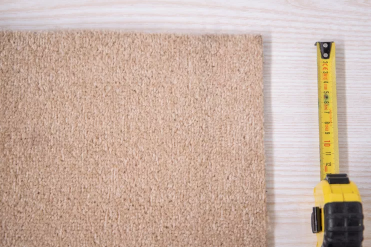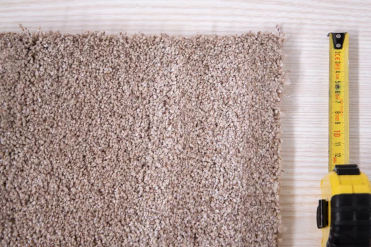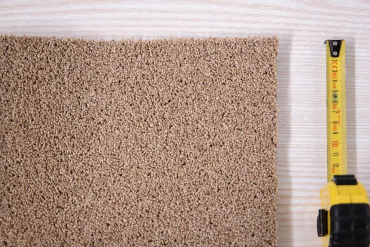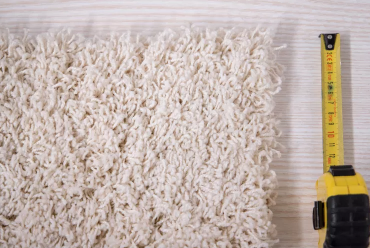There are various types of carpet fibers, but the most common are nylon, polyester, polypropylene, acrylic, and wool. Carpets are made by threading these fiber yarns through the backing material, just like buttons are sewn onto a shirt. These fiber loops can be left intact or cut at a variety of angles and lengths. The treatment of the fiber loops is called carpet pile.
When choosing a carpet, two characteristics of the carpet are the main considerations: the type of natural or synthetic fibers used in the construction, and the fluff (how the fiber loops attach to the carpet backing). These properties determine the comfort of the carpet, its feel on the foot, and its abrasion resistance.

Here are the common carpet terms to know and the types of carpet fibers and pile options to consider.
Carpet Terms
Rugs have their own vocabulary that you will come across when buying rugs. Learn the meaning of four key terms to help you research and choose rugs with confidence.
- Fibers: The surface of the carpet is made of bundles of fibers. Carpet fibers can be natural or synthetic.
- Pile head: Down refers to the height of the fiber loop on the surface of the carpet. Carpets can have low pile, high pile, or deep pile made from higher fibers.
- Density: Density refers to how tightly the fibers at the bottom of the carpet are to each other. Carpets with higher densities are generally more durable.
- Pads: A mat is a mat or material that is installed under a carpet. The mat insulates, cushions, absorbs sound, and prevents the bottom of the carpet from wearing out too quickly. The mat also prevents stains from seeping in and damaging the subfloor.
Carpet Fibre and Pile Options
01. Nylon

Nylon is very soft, durable, stain and abrasion resistant. It is one of the most popular carpet fibers, and many synthetic carpets are made from nylon. It has good wear-resistant, mildew-proof, mildew-proof and corrosion-resistant properties, and is easy to dye and has good color retention. It’s usually affordable – cheaper than wool, but more expensive than other synthetic materials. These rugs can last between 12 and 15 years if properly cared for, making them one of the most durable synthetic fibers.
02.Polypropylene (Olefin)

Polypropylene is another popular carpet fiber used in commercial applications and increasingly residential environments and is almost as soft as nylon. Polypropylene fiber, also known as olefin, is similar to natural wool and is often used as an alternative to synthetic wool. This fiber is highly resistant to dirt, but it can easily stain and get oily, which can lead to dirt accumulation. 2However, it is relatively easy to clean – and in some cases even bleach can be used. Polypropylene is not as elastic as nylon, so it is often used in ring carpets, such as Berber carpets. Polypropylene costs slightly less than most nylon carpets, but higher than polyester and acrylic.
03. Polyester

Polyester fibers are prized for their ability to stay vibrant and resistant to fading. Since it is a man-made fiber, it is less allergenic than other fibers. A type of polyester carpet called polyester/PET is made from recycled plastic bottles and is very eco-friendly. Its main disadvantage is that polyester tends to flatten under weight, which is a poor choice for high-traffic areas. It is also susceptible to oil stains, which are difficult to remove from polyester fibers.
04. Acrylic Fiber

Sometimes marketed as “synthetic wool” because acrylic has the feel and look of wool, but at a fraction of the price of wool, it has good antistatic, moisture, mildew, fade and stain resistance. But it’s not a very durable material and doesn’t hold up well in high-traffic areas either. Sometimes blended with wool. Acrylic resins can sometimes turn brown if they are contaminated with certain alkaline chemicals, such as those found in cleaning products.
05. Wool

Wool is a natural, luxurious, durable material that is the softest carpet fiber you can find. Unfortunately, low-grade wool is easier to dye, while high-grade wool is extremely expensive. Some manufacturers combine wool with synthetic fibers to create carpets that have the best of both worlds. Wool/acrylic blends are especially common.
Pure wool rugs contain no chemicals or additives, which makes it a great choice for people with chemical allergies or sensitivities. But as a natural material, wool is susceptible to damage from molds and mildew that feed on organic matter. 4Therefore, wool is not a good choice for areas with high humidity and moisture problems.
and moisture problems in areas where wool is not a good choice.
06.Loop Pile

Also known as “uncut pile” or “Berber fleece” (named after a special type of knotted pile used in North Africa), terry leaves the entire yarn loop intact on the surface of the fabric. These rugs tend to be very durable and stain-resistant, making it easier to clean the rug. These types of rugs are ideal for high-traffic commercial applications or high-traffic home areas, such as recreation rooms. Terry carpets also do not show indentations caused by footprints and vacuum marks.
Terry rugs come in a variety of forms, such as horizontal terries (all the same length of fiber loops) and patterned terry (terry heights are different). Carpets can also have a cut-out ring structure where some fibers are cut and others are looped.
A special type of terry carpet is sisal carpeting, in which terry of different colors and sometimes different heights are arranged in rows to produce a textured, patterned surface.
Warning: Not only are uncut pile loops less soft and unfilled than cut pile fibers, but experts warn that they can also be a tripping hazard, especially for pets or small children.
07.Cut Pile

Cut pile is a type of carpet in which the exposed fibers are cut off. This often results in a carpet that is soft, inviting, and easy to clean. Different styles can be created by changing the angle of the cut coil, or by treating the thread differently before and after inserting the backing. Cut pile comes in different lengths and thicknesses, and these carpets work well when carpeted throughout the house because it blends well between the rooms.
The downside is that cut pile makes it easier to see footprints and vacuum marks. This tendency can be reduced by the twist of the fibers. The individual fibers contain twist, which helps the carpet resist tangling and crushing. The heavier the twist, the more resistant the carpet will be. The powerful twist also helps to create textures that hide wear and dirt.
While cut pile rugs are more popular than terry rugs, cut pile rugs are less durable and need to be replaced more often. They come in a variety of variations, including long-pile carpets, a term that refers to deep-pile carpets with long-haired fibers that are soft to the touch. Wool carpets are now relatively rare, but other special cut pile carpets (described below) are very popular and used for special effects.
08.Saxony Cut

The term Saxon fleece refers to a special type of cut pile carpet with very soft and dense fibers. The relatively short fibers stand upright on top and bottom, creating a dense, hairy surface. The disadvantage of this style is that the threads can be easily crushed by feet and vacuum cleaners, leaving marks on their surface. It is also prone to wear and stain, which makes Saxon carpets a most suitable floor treatment for use in less crowded areas, such as formal living rooms or dens. They are also a bit more expensive than traditional cut pile carpets.
09.Plush Pile

Sometimes referred to as velvet cut pile, this style is a variant of cut pile in which the fibers are shorter than Saxon cut pile and are very dense, creating a rich and luxurious carpet surface. Unfortunately, this carpet style is quite temperamental. Velvet rugs are susceptible to abrasion, abrasion, and exposed footprints, and should only be used in luxurious, low-traffic environments.
10. Textured Cut

The term “textured cut pile” refers to a form of cut pile carpet with uneven fiber length. They are also twisted into a helix using a special steam treatment that curls the individual threads so that they remain kinked. This style is also known as “trackless” because it does not show footprints and other markings on its surface like other cut fleece, such as Saxony. The spiral does not reflect light as well as a straight line, so it is not as noticeable when the spiral is crushed. The pile is suitable for medium and high-level traffic areas.
11.Frieze-Cut Pile

The term “ribbon cut pile” refers to a type of carpet in which relatively long cut fibers are twisted together and kinked, causing them to curl irregularly across the carpet’s surface. (This style is sometimes referred to as a California shag.) This highly durable style tends to hide dirt and abrasion, making it suitable for high-traffic and commercial environments.
12.Sculpted Pile

Carved carpets have both terry and cut pile fibers, which create a change in height and texture on the carpet surface. These rugs are sometimes referred to as cut-out ring rugs or patterned rugs. The different fiber cuts are sometimes arranged in a geometric pattern, giving the carpet a three-dimensional texture. Different fiber cuts can have the same length (horizontal cut and loop), or they can have different heights (texture cut and loop).
Carpet Underlayment
The longevity of a carpet largely depends on the type of carpet underlayment you choose. Poor quality, incorrect use, or no use of mats can cause the carpet to wrinkle, crepe, delamination, damage the seams, or wear out the carpet quickly, not to mention void the carpet’s warranty. 5
Carpet underlayments are typically made of foam, synthetic fibers, or rubber and are available in different grades, densities (weights), and thicknesses. However, keep in mind that for some rugs, thicker is not always better. For example, Berber carpets require thin and sturdy mats. If you have a radiant floor, you’ll need a non-insulated carpet mat. 6
Tip: You don’t always need to accept a promotional rug mat that is usually provided free with your rug. Talk to your retailer about other options, as you may prefer to purchase higher-quality upholstery to extend the life of your rug.
Frequently Asked Questions
- What is the most durable type of rug?
Nylon rugs have been the traditional winners of the most durable rugs. However, Triexta is an emerging carpet fiber that is widely considered to be more durable than nylon.
- What is the lowest maintenance carpet?
Short-haired nylon carpets are considered to be the easiest to clean and maintain.
- What type of rug is the cleanest?
Carpets made of synthetic fibers will stay the cleanest because they don’t absorb stains easily. It is very easy to remove stains from synthetic carpets.


